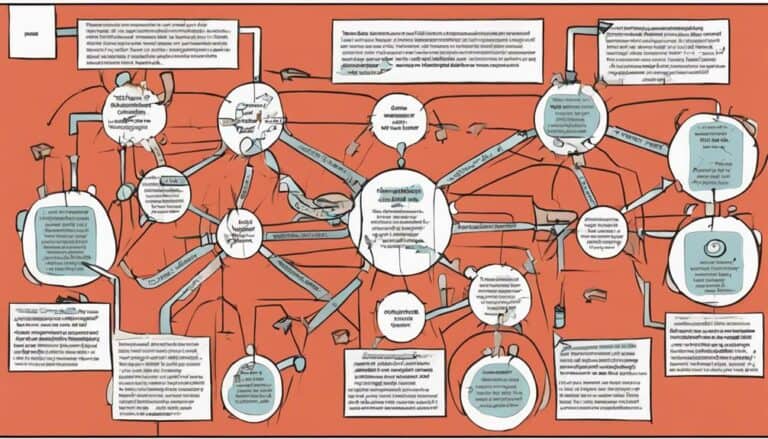As you navigate the intricate landscape of decision-making models, imagine them as tools in a craftsman's workshop, each serving a unique purpose. From the rational model's structured approach to the intuitive model's reliance on gut feelings, various components shape these models.
But what truly makes them tick? Let's explore the intricate elements that underpin these models, guiding you towards a deeper understanding of how decisions are made and the impact they have on organizational outcomes.
Key Takeaways
- Rational Decision-Making Model emphasizes problem definition, criteria establishment, alternative generation, and logical evaluation for informed decisions.
- Intuitive Decision-Making Model relies on quick gut feelings, past experiences, and pattern recognition for efficient decisions.
- Recognition-Primed Decision Model prioritizes experience and expertise for rapid pattern recognition and quick decision-making in time-pressured situations.
- Creative Decision-Making Model values new perspectives, risk-taking, flexibility, and creativity to inspire inventive and visionary choices.
Components of Rational Decision Model
When implementing the Rational Decision Model, the initial step involves defining the problem at hand with precision and clarity. This essential stage sets the foundation for the entire decision-making process. Once the problem is clearly identified, the next components of the rational decision model come into play.
Judging criteria are established to evaluate potential solutions effectively. It's vital to determine the importance of each criterion to weigh the alternatives properly.
Generating alternative solutions is a key aspect of the rational decision model. By exploring multiple options, you increase the likelihood of finding the most suitable solution. Systematic evaluation of these alternatives is then conducted, following logical steps to assess each solution thoroughly. This structured process allows for a thorough analysis, enabling you to make an informed decision based on a rational approach.
Embracing the rational decision model empowers you to navigate complex scenarios with a methodical and calculated strategy.
Elements of Intuitive Decision Model
Utilizing quick, instinctual decisions based on experience, the Intuitive Decision-Making Model emphasizes pattern recognition and expertise reliance for efficient decision-making under time constraints or limited information availability. In this model, individuals often rely on gut feelings and past experiences to make rapid decisions. However, the effectiveness of the Intuitive Decision Model diminishes in unfamiliar scenarios compared to structured approaches.
Here are some key elements of the intuitive decision-making model:
- Quick decisions based on gut feelings and past experiences.
- Instinctual approach to decision-making, emphasizing speed and efficiency.
- Reliance on pattern recognition to identify familiar situations and make rapid judgments.
- Utilization of expertise and knowledge to guide intuitive choices.
- Challenges arise when faced with unfamiliar scenarios due to the model's reliance on past experiences for decision-making.
Key Factors in Recognition-Primed Model
Key components that drive the effectiveness of the Recognition-Primed Decision-Making Model include reliance on experience and expertise for swift decision-making processes. In this model, individuals draw upon their expertise to recognize patterns in the information presented to them, allowing them to swiftly select a course of action based on their deep experience.
This method proves valuable in situations where time pressure necessitates quick decisions. The Recognition-Primed Model prioritizes rapid pattern recognition and intuition over a more structured analysis process. It's clear that expertise and experience are pivotal in ensuring the success of this decision-making approach.
Critical Aspects of Creative Decision Model
In the area of decision-making, fostering innovative and out-of-the-box thinking is paramount, as emphasized by the Critical Aspects of Creative Decision Model. This decision model focuses on nurturing creativity, originality, and unconventional ideas to pave the way for unique solutions.
Here are the key elements of the Creative Decision Model:
- Encourages exploring new perspectives and challenging assumptions.
- Embraces risk-taking for breakthrough decisions.
- Prioritizes flexibility, adaptability, and open-mindedness.
- Sparks creativity by incorporating elements of imagination, experimentation, and curiosity.
- Aims to inspire inventive and visionary choices through problem-solving.
Factors Influencing Bounded Rationality Model
Considering the complexity of decision-making processes, understanding the factors that influence the bounded rationality model is essential for maneuvering through constrained decision environments efficiently and effectively. The bounded rationality model revolves around making a 'good enough' decision within the limitations of time and information constraints. This model heavily relies on mental shortcuts to simplify complex decision-making processes and acknowledges that individuals may not have the capacity to consider all possible alternatives. By embracing bounded rationality, individuals can make efficient decisions in situations where exhaustive analysis is not feasible. However, it is critical to grasp the limitations of bounded rationality to ensure effective decision-making, especially in time-sensitive scenarios.
| Factors Influencing Bounded Rationality Model | Description |
|---|---|
| Mental Shortcuts | Simplifying complex decisions |
| Time Constraints | Making decisions efficiently |
| Information Constraints | Seeking a 'good enough' decision |
| Limited Consideration of Alternatives | Acknowledging capacity constraints |
| Understanding Limitations | Ensuring effective decision-making |
Conclusion
You've explored the key components of decision-making models, from the logical steps of the rational model to the instincts of the intuitive model.
Remember, just like a skilled chef combining different ingredients to create a delicious dish, effective decision-making requires blending these components in the right proportions.
By understanding and utilizing these models, you can navigate challenges, make informed choices, and steer your team towards success.
Keep mixing, tasting, and adjusting until you find the perfect recipe for your decision-making process.

